
The unique Onto Onsen,, located in the Nagato-Yumoto Hot Spring resort, reopened after a grand renewal in March 2020. This hot spring is said to be the oldest in Yamaguchi Prefecture, boasting a history of nearly 600 years. The Chikurin-no-Kaidan, or bamboo grove stairway, connects the Nagato-Yumoto Hot Spring parking lot along National Route 316 with the main street of the resort. The hundreds of bamboo stalks create an atmosphere of calm. The path is lined with lanterns designed after a motif based on the nearby Otozure river flowing next to them. (staff) text:Nao Ohmori photo:Daisuke Abe(bird and insect), Koji Mizusaki(Loop Photo Creative)
The Nagato-Yumoto Hot Spring is one of the most famous hot spring resorts in Yamaguchi Prefecture. And the Onto hot spring that symbolizes the resort is enriched by a complexity of history and legends. Let’s unravel the mysteries together.
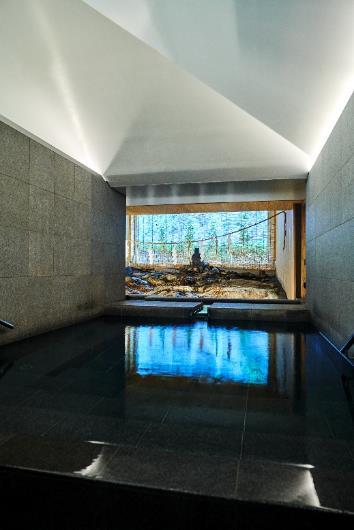
This is the men’s bath at the Onto Onsen. The figure of Sumiyoshi Daimyojin sits atop the bedrock from which the hot spring water flows. The Shimenawa woven straw piece comes from the Sumiyoshi Shrine in Shimonoseki, Yamaguchi Prefecture. The women’s bath is located just on the other side of the wall, and features roughly the same design.
Onto
Address: 2265 Fukawa-Yumoto, Nagato City, Yamaguchi Prefecture
Tel: 0837-25-4100
Business hours: 10:00 – 22:00
Closed: 3rd Tuesday of every month (may vary during holidays)
Admission: 900 for adults and
400 yen for children (aged 4 to 12).
Children under the age of 3 are free of charge.
www.onto.jp
Onto, the oldest hot spring in Yamaguchi Prefecture
A famous hot spring gifted by the god Sumiyoshi Daimyojin
The Otozure river flows through the middle of the Nagato-Yumoto hot spring resort. The Onto Onsen located on its banks has been part of the daily lives of the residents for centuries. The history of the hot spring dates back 600 years.
Legend has it that one night, the third head priest of Taineiji Temple, Joan Shuzen, was walking the temple grounds, not far from the Onto hot spring, when he came upon a man engaged in Zen meditation on a rock. Joan Shuzen asked the old man his name,and the old man answered with a Waka poem, “I am the God Sumiyoshi in the hidden place, now and of old, where the wind blows through the pines,” and his true form was revealed to be the God Sumiyoshi Daimyojin of Ichinomiya in the Province of Nagato. Joan Shuzen invited the old man into the temple, and instructed him in the Way of the Buddha. Then, in 1427, when the old man was given a brocade robe by Joan Shuzen, he said, “I have brought forth a hot spring. Please use it if you like,” to repay the kindness, and he transformed into a dragon and flew up into the sky.
That was the start of the Onto hot spring. Today, the source of the hot spring remains in the possession of Taineiji Temple, which to this day also possesses many records and cultural artifacts that back up the legend, such as a wooden statue of Sumiyoshi Daimyojin wearing a brocade robe. So what is legend and what is fact? We spoke with Keijo Iwata, the 53rd head priest of the temple, to find out..
“Taineiji Temple is a temple of the Soto School founded in 1410 by local lord Washizu Hirotada, a member of a branch of the Ouchi Clan. In those days, schools of Zen Buddhism, such as the Soto School, were strongly tied with local feudal lords, and temples were typically accompanied by hot springs as a place for priests to purify themselves during spiritual training. Meanwhile, the Ouchi Clan had amassed great riches through trade with China and Korea. Sumiyoshi Daimyojin is a god who protects travel across the sea. Given this background, it is possible that the Ouchi Clan colluded with Taineiji Temple and Sumiyoshi Shrine to construct the story for political purposes.”
Before the Onsen’s recent renovation, there was another hot spring adjacent to it called Reito which was once used only by warriors and priests, while Onto was for use by the common people. It is said that the priests said prayers of gratitude to the gods before getting into the bath. A stone statue of Sumiyoshi Daimyojin which has been passed down through the ages sits in the Onto bathhouse. Throughout, one can sense hints of why this hot spring is known as Shinju-no-yu, or A God’s Bath. “The Mori Clan came to rule over the entire Chugoku region after the fall of the Ouchi Clan. The reports on temple activities submitted by Taineiji Temple to the Mori Clan always contained an episode on the ‘hot spring gifted by the God Sumiyoshi.’ So surely Onto has been known as a sacred hot spring for many centuries.”
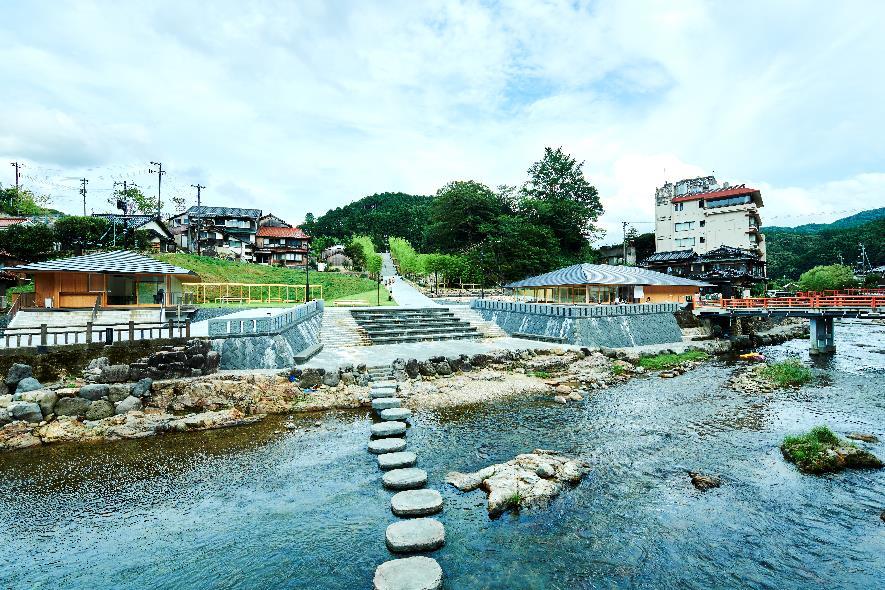
The Onto Hiroba (Plaza) is located almost at the center of the resort along the Otozure river. The Onto hot spring is on the right, and the Onto Shoku restaurant on the left.
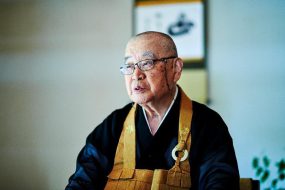
Keijo Iwata, 53rd head priest of Taineiji Temple. The cemetery located on the temple grounds contains a stone called the Sumiyoshi Daimyojin no Zazenishi, or Zen Meditation Stone of Sumiyoshi Daimyojin.
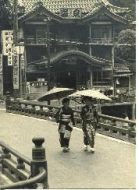
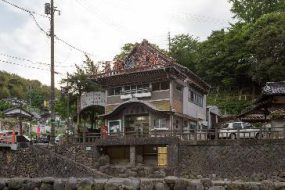
Right: The Onto hot spring before the renewal in 2020. The onsen has always served as a symbol of the hot spring resort and a place to relax for the local residents. Left: The Onto hot spring in the late 1950s.
Left photo by Kenichi Murakami (Nagato City Board of Education)
The Sumiyoshi Shrine sits atop the hill over the Onto Onsen. The renovations of the hot spring have resulted in a new scenic view created together with the Sumiyoshi Shrine and the Otozure river.
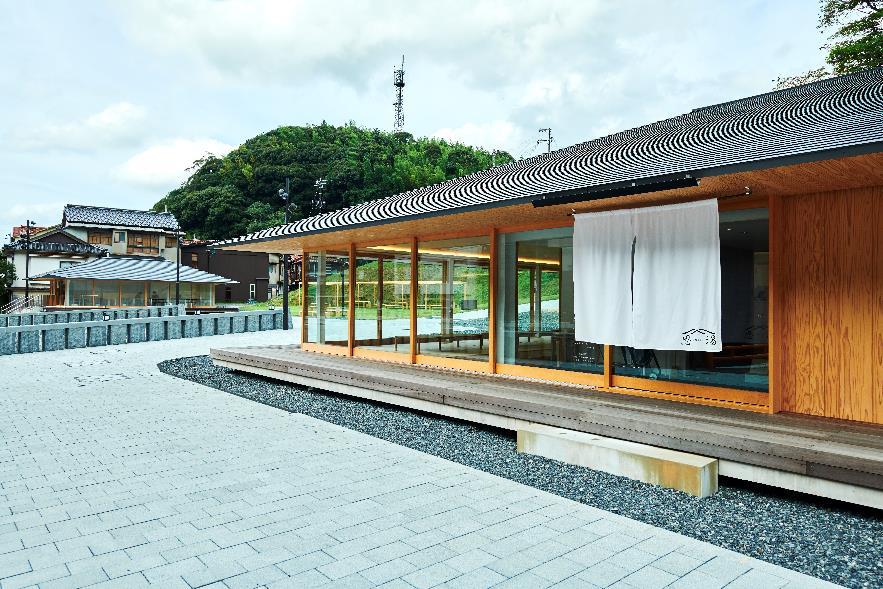
The Onsen is shown at the front, while the glass building on the other side of the Onto Plaza is the Onto Shoku restaurant. Both structures are single story so as not to interrupt the scenery in the hot spring resort. Visitors can also spend a leisurely moment on the long porch, called an Engawa.
A harmonious space formed by buildings and nature
The sky opens wide before you when you descend the bamboo grove stairway (Chikurin-no-Kaidan) to the green lawn of the Onto Plaza, accompanied by the soothing murmurs of the Otozure river resonating in the air. With the Onto hot spring on the left and the Onto Shoku restaurant on the right, the structures blend seamlessly into the nature around them, becoming a natural part of the landscape.
The Onto hot spring and Onto Shoku restaurant were both designed by the Shohei Oka Architectural Office. We interviewed Shohei Oka to learn more.
“The Onto hot spring waters bubble up from the bedrock covering the ground, so the conditions here are quite special. In ancient times, people likely bathed in the standing pools of water where it bubbled up from the bedrock. Accordingly, we designed baths to accept this naturally flowing water to recreate that natural approach.”
When you get into the baths, before you is the natural bedrock as it has always been, and you can watch the water flow from it. Furthermore, the Onto hot spring was built directly over the bedrock from which the water comes, so you can see that water flows into the baths from the bottom as well. As a result, here you can enjoy hot spring water of the highest purity. That water is a simple alkaline hot spring (pH 9.62). The hot spring water flows from the bedrock at 39° C, making it soft and gentle as it embraces your skin.
Also, our insistence on using only spring water direct from the source resulted in baths that match the water volume in size. We also maintained a bath depth commensurate with Onto tradition. Some records indicate that the baths were already about 1 meter deep during the Edo period.
“Also known as Shinju-no-Yu (A God’s Bath), Onto is located right next to Sumiyoshi Shrine. Accordingly, we decided that it would be best to design the buildings, so they become a part of the shrine. Thus, the Chiyobashi Bridge in front of the Onto hot spring is like the entrance to a sacred place. Passing from the door to the watch room is a stairway that leads up to Sumiyoshi Shrine. This represents a new path for worshippers visiting the shrine.”
The composition of the building places the watch room in the center, half occupied by baths and half occupied by a rest area.
“Three of the walls around the rest area are full length glass. And the dining building across from it is also an almost identical construction. The plaza, Otozure river, and dining building come together to form a single space because we extended the eaves to add a long porch, or Engawa, along the building.”
The Onto continues to serve as a symbol for the Nagato-Yumoto Hot Spring resort.
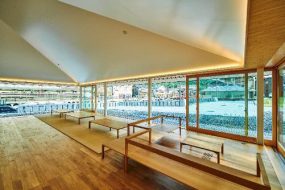

Top: A spacious open rest area. The Tatami mats placed on the floor allow guests to go barefoot. Here, refreshments such as beer and soft serve ice cream are also available.
Bottom: The corridor passing in front of the watch room leads to a stairway to Sumiyoshi Shrine.
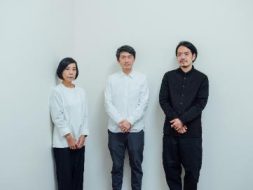
The Shohei Oka Architectural Office is a joint venture run by Shohei Oka (center), Yuko Hirose (left), and Tomotaka Yasui (right). The firm is involved in community development to increase community value, such as their project to open the Busshozan Hot Spring in Takamatsu City, Kagawa Prefecture.
The designer of Onto also designed new guest rooms at a local inn
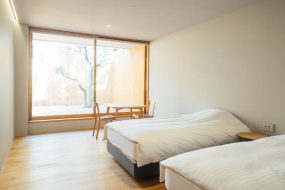
The Shohei Oka Architectural Office was also involved in the renewal of the Gyokusenkaku Inn, The guest rooms were designed as simple spaces in which the terraces continue naturally from the rooms. The rooms are floored with chinquapin wood grown and harvested in Nagato.
Here we introduce inn proprietors Kazuhiro Otani of Otani Sanso, and Shuichi Ito of Gyokusenkaku, both born and raised at the Nagato-Yumoto Hot Spring resort. We asked them about the appeals of Onto Onsen.
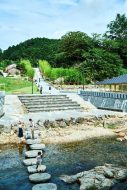
The Onto Plaza, with shaded spots, is situated between the Onto hot spring and the Onto Shoku restaurant , while the Gangi Plaza can be found by descending to the Otozure river.
Onto is the symbol of the Nagato-Yumoto Hot Spring
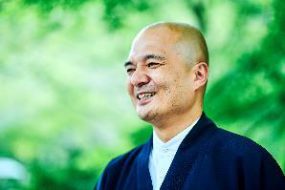
Kazuhiro Otani,
Proprietor of Otani Sanso.
Enjoy this hot spring resort along the banks of the Otozure river.

Shuichi Ito,
Executive Director of Gyokusenkaku
–How old were you both when you first used the Onto baths?
Otani: I was in the first grade of elementary school. It really surprised me, and filled me with joy as well. The baths of Onto were so deep, my feet didn’t reach the bottom yet. Intuitively, I immediately fell in love, because, let’s face it, hot springs are fun.
Ito: For me it was the opposite. I was afraid of the Onto baths because my feet didn’t reach the bottom, and I thought I would drown. I think the first time I bathed here was when I was in nursery school. But once I entered elementary school and learned how to swim, it was no longer scary, so after playing with friends, we would head straight to the Onto baths.
Otani: The standard course was to go to the Onto baths after playing at the Otozure river.
Ito: Onto was at the center of our playground, so to speak. There was the Otozure river, the grounds of Sumiyoshi Shrine, and then of course there was the Yumoto Hot Spring Noryo Bon-odori Festival, where the Yagura stand would be erected over Chiyobashi Bridge in front of Onto, and everyone would dance along the road beside the Otozure river.
Otani: The Onto hot spring and the Otozure river are deeply intertwined, and part of the daily lives of the people who live here. There is a washing spot on the riverside, and people would wash their laundry there using water flowing from the Onto hot spring until the early 1960s. That was a social gathering place for the locals.
— The Onto Onsen was originally a publicly built and operated facility, but it became privately owned after the renovations. Both of you are joint proprietors of Nagato Yumori, the organization that now manages Onto. What are your thoughts on the new role of Onto?
Otani: Joining the members of Nagato Yumori are Masako Aomura, the descendant of a local samurai who was once responsible for managing the hot springs at Taineiji Temple long ago, and Shinichi Shiraishi, a graphic designer based in Nagato City. The philosophy of Nagato Yumori is to create a unique lifestyle culture that matches the lives of the citizens through the use of the public spaces in the Nagato-Yumoto area. Isn’t it an ideal lifestyle to use the hot spring baths after work, and then maybe enjoy Yakitori and beer on the riverside afterwards? Our hope is to offer just such a lifestyle, one that fits with these surroundings, with the local residents and travelers who visit here. And we believe that the Onto hot spring symbolizes that lifestyle.
Ito: We want the guests staying at the hot spring inns to also join us in this bath of culture, so to speak. You can enjoy the illumination of the Chikurin-no-kaidan (bamboo grove stairway) or Koyo-no-kaidan (autumn leaves stairway), or gaze at the Ayu sweetfish and other river fish swimming in the beautiful Otozure river on your way back and forth between the inn and Onto baths, and I think that brings the enjoyment of this hot spring resort and the trip itself to a whole new level.
Otani: A hot spring bath is a sort of utopia. Locals and visitors can interact with each other from the same position, irrespective of age or occupation. So I believe that Onto also functions as a new place to interact.
— So the lifestyle culture centered around Onto is itself the greatest appeal of this place, and its greatest tourism resource?
Ito: Yes, and Onto is an opportunity for us to experience hot spring as well. The perpetuation of Onto and the perpetuation of this hot spring resort are closely linked, and they must continue and grow together.
Otani: I’m sure that visitors here are enthralled by the sight of the locals enjoying their daily lives here. And when the visitors fall in love with this place, it brings pride to the locals in turn. My hope is that together, we can build an even better relationship.
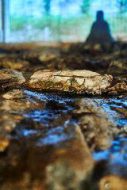

Top: One can view the hot spring water bubbling up from the bedrock from the Onto baths. A stone statue of Sumiyoshi Daimyojin watches over the bathers from the back. Bottom: Lanterns are floated on the river as the head priest of Taineiji Temple reads sutras as part of the Yumoto Hot Spring Noryo Bon-odori Festival held every year in August.
The Onto Shoku restaurant offers a menu of healthy dishes carefully prepared with selected ingredients. The restaurant serves all manner of needs, including lunch, teatime, and dinner.

Nagato Egg-Chicken Rice. This dish is also available as a set including Marinated Seasonal Vegetables and Kuro-kashiwa (black chicken) Soup.

Rie Kawada trained as a chef in Tokyo before returning to her hometown of Nagato.
After soaking yourself in the hot spring baths of Onto, it’s time for a visit to Onto Shoku restaurant across the way. This restaurant offers a menu featuring such dishes as Choshu chicken, a local delicacy of Nagato City, and handmade tofu, and the gentle flavors that seem to permeate your body are the perfect accent to fill you after a bath.
“What I focus on is cooking in a way to bring out the natural Umami, or savory flavor, of the ingredients. I really want my guests to enjoy the flavors of Nagato ingredients, such as the flavorful and tender Choshu chicken, the thick handmade tofu, and the fresh seasonal vegetables grown and harvested locally,” says Rie Kawada, chief chef of Onto Shoku.
One of the more popular dishes on the menu, one which seems to condense the delicious flavors of Nagato into a single experience, is the Nagato Egg-Chicken Rice which features rice in a broth made from Choshu chicken steamed in liquor topped with steamed sweet and spicy Choshu chicken wings, and covered in a fluffy egg sauce made from eggs procured locally in Yamaguchi Prefecture. We also recommend that you order a side dish of Marinated Seasonal Vegetables that will give you an experience of the depth of flavor of the local produce here.
On a sunny day, you can take out your food and drink and enjoy it in the breeze along the banks of the Otozure river.
Onto Shoku
Address: 2270-5 Fukawa-Yumoto, Nagato City, Yamaguchi Prefecture
Tel: 0837-25-4333
Business hours: 11:00 – 22:00 (21:00 last order)
Closed: Wednesdays
www.ontoshoku.jp
A free map for walking around the hot spring resort called Osoto Heaven Map is available. Get your copy when you visit and enjoy taking walks around the Nagato-Yumoto Hot Spring resort.
How to enjoy and fall in love with the Nagato-Yumoto Hot Spring resort
The greatest attraction of the Nagato-Yumoto Hot Spring resort is the lifestyle and culture that has been created and nurtured here. Children play in the Otozure river that flows through the center of the resort,and locals relaxi on the terraces set up around the river and everyone bathes at the Onto Onsen. Evenings are spent eating and drinking at the resort’s unique restaurants, resting on the benches along the riverside paths, enjoying the changing seasonal landscape, and the illumination throughout town. All of these rich experiences are available to visitors here as well.
The Association for the Utilization of Nagato-Yumoto Osoto is working to improve and beautify the use of public spaces such as the Otozure river and roads in the hot spring resort area. With Osoto (Open Air) Heaven as their slogan, the Association continues to plan numerous ways for residents and visitors to enjoy their walks in the community.
With the murmuring of the river and the tweeting of birds serving as the background music to your walks, your hours of enjoyment at the Nagato-Yumoto Hot Spring resort will make you want to return over and over again.
A cafe where you can enjoy Hagi ware creations by young potters
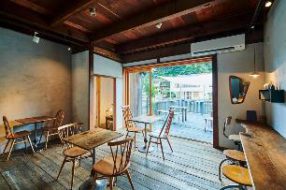
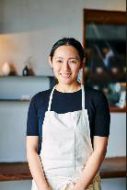
Right: Kazuyo Yokoyama, the second-generation proprietor. Left: The cafe offers a comfortable space with its plastered walls, riverside wood deck, and atmospheric antique furniture. The cafe exhibits and sells ceramics selected according to a theme of items that can be used every day.
Cafe & Pottery Oto
This cafe and gallery occupy a 50 year-old renovated wood framed home standing on the side of the Otozure river. The cafe exhibits and sells ceramics by three local artists who operate the Hagi ware Fukawa kiln. Works by these artists are also used to serve the handmade sweets and drinks served in the cafe space. The proprietor is sure you will be pleased with any dish on the menu.
Address: 1261-12 Fukawa-Yumoto, Nagato City, Yamaguchi Prefecture
Tel: 0837-25-4004
Business hours: 10:00 – 16:00
Closed: Wednesdays, Thursdays
Instagram: @oto_cafe
Unique Dorayaki sweets made with citrus fruits
Akebono Cafe
This cafe, attached to Hoshino Resorts KAI Nagato, is open to all visitors whether or not they are staying at the inn. The cafe offers three types of Dorayaki sweets: Azuki,Natsu Mikan, and Yuzukichi.
Address: 2229-1 Fukawa-Yumoto, Nagato City, Yamaguchi Prefecture
Tel: 0570-073-011 (Kai Reservation Center)
Business hours: 11:00 – 16:00 (subject to change)
Closed: No regular holidays
www.kai-ryokan.jp/nagato
Kawara Soba and bar
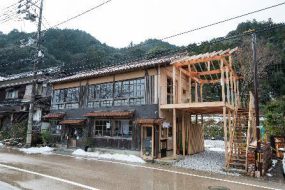
Daigo Nagaya
Owner Daigo Kimura renovated this historic wooden building on his own. Kawara Soba Yanagiya, a noodle restaurant, occupies the first floor, while The Bar Nagato occupies the second.
Uncompromising flavor achieved through trial and error
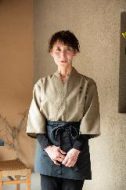
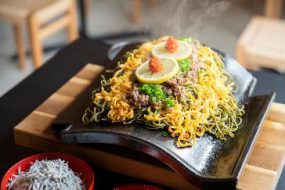
Right: Kawara Soba (single serving). The crispy noodles placed over the hot Kawara tile are also delicious. Left:Proprietor Misae Okazaki.
Kawara Soba Yanagiya
This shop has long pursued the ultimate taste of Kawara Soba, a local noodle dish in Shimonoseki, Yamaguchi Prefecture. The result of those efforts, and the pride of the chef, is a richly flavorful serving of green tea soba topped with Kinshi Tamago (strings of scrambled egg), savory beef, and local green onions from Nagato. They also offer Mitarashi Dango sweets (162 yen each) at the front of the shop.
Address: 1F, Daigo Nagaya, 1325-1 Fukawa-Yumoto, Nagato City, Yamaguchi Prefecture
Tel: 080-9185-3070
Business hours: 11:00 – 19:00 (Last order: 18:30)
Closed: Tuesdays, Third Wednesday
Instagram: @yanagiya.yumoto
Otozure River Terrace

Several terraces have been installed along the banks of the Otozure river for use by anyone. These are great spots to enjoy your takeout meals.
Steppingstones in front of the Onto Plaza
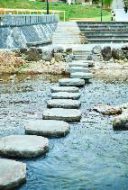
There are steppingstones laid across the Otozure river in five locations, allowing you to cross to the other side. Both children and adults enjoy playing in the river here during summertime. It is not uncommon to see swimmers here as well.
Okiza (Otozure Terrace)
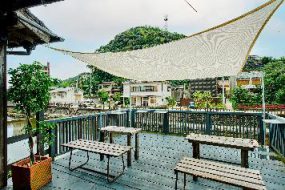
This terrace belongs to Cafe & Pottery Oto. Here you can enjoy the cafe’s menu on the terrace with a close-up view of the Otozure river.
Benches and planters
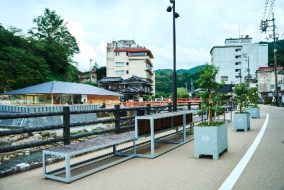
Benches and planters are installed to match the environment around the Otozure river to make your strolls through the area more comfortable. Why not grab a bench to enjoy a break while you gaze on the river?
The Bar Nagato
Owner Daisuke Kuroda has been bartending for about 30 years and serves cocktails made with local fruit, rare whiskeys or anything else your heart desires. “I would be more than pleased if the time spent here becomes a memory of your vacation.”, he explains
Address: 2F, Daigo Nagaya, 1325-1 Fukawa-Yumoto, Nagato City, Yamaguchi Prefecture
Tel: 070-4426-8169
Business hours: 18:00 – 24:00 (Last order)
Closed: Mondays
yumotoonsen.com/food/the-bar-nagato
365+1 Beer
This craft beer brewery was launched in 2021 after renovating an old pharmacy. Run by husband and wife Takanao and Ayaka Ariga 365+1 Beer offers six standard brews and several seasonal beers.
Address: 1247-2 Fukawa-Yumoto, Nagato City, Yamaguchi Prefecture
Business hours:Please check Instagram for details: sanrokuroku_beer
Onto Shoku
The Onto Shoku restaurant offers a menu of healthy dishes including a delicious Egg-Chicken over rice using local tender Choshu chicken, thich handmade tofu and local vegetables.
Onto Shoku
Address: 2270-5 Fukawa-Yumoto, Nagato City, Yamaguchi Prefecture
Tel: 0837-25-4333
Business hours: 11:00 – 22:00 (21:00 last order)
Closed: Wednesdays
www.ontoshoku.jp
Local Flavour; Nagato Yakitori
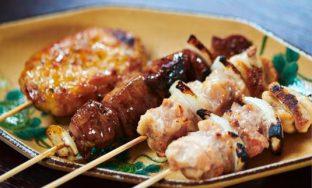
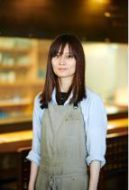
Tsukune (ground chicken), Kimo (Liver),
Momo (thigh). Proprietor Sakurako Aomura. Takeout also available.
Sakura Shokudo
Yakitori is the soul food of Nagato. The proprietor here, procures fresh chicken every morning and skilfully grills it to order. The Nagato style is to spear regular onions on the stick between pieces of chicken and topping it off with garlic powder.
Address: 1272-6 Fukawa-Yumoto, Nagato City, Yamaguchi Prefecture
Tel: 0837-25-3660
Business hours: 11:00 – 14:30 (Last order: 14:00), 17:00 – 22:00 (Last order: 21:30)
Closed: Thursdays
Instagram:@_sakurashokudou_
https://yumotoonsen.com